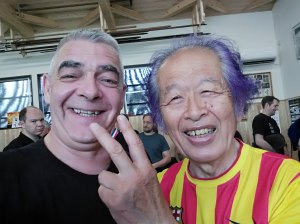Mutō Dori Is Not Mutō Dori
From Shiro Kuma's Blog by kumablog
During class, Sensei spoke about ishitobashi again (skipping stone) and did many applications with Mutō Dori. The sword was either in Uke’s hand or Tori’s hand. We have already covered the complexity of Mutō Dori in this blog because this is the essence of the Bujinkan.
Sensei often refers to it but last night it was even more complex than before.
But we have to refresh our memory before I try to explain what Sensei said.
“Many people think that Mutō Dori is about the opponent wielding a sword while you have none, but this is not the case. Even if you have a sword, Mutō Dori starts with the development of the courage to face an opponent with the preparedness of not having a sword.
This means if you don’t thoroughly train in taijutsu you will not obtain the knowledge of the refined skill of Mutō Dori. Therefore, you must first know the purpose of the path of training. If you are unaware of this and proceed down the path of thinking that sword training is only about cutting and thrusting, then there is a danger that you will go down the path of the evil sword. The sword harnesses a pure essence that is life-giving – one who cannot live the way of the sword saint will foolishly think that the sword is only a tool for cutting. Those who do this can never achieve enlightenment.
The warrior’s heart is ruled by preparedness, and nature’s heart, or god’s heart, is fundamental. The heart also governs the warrior’s physical kamae. Therefore, if there is no unity in spirit and body, you will never understand the reason for being a martial artist. You will leave no vulnerability or opening (suki) if you remain consistently prepared.(…)
Many people do not fully understand Mutō Dori, and believe it is simply the knowledge of defending against a sword attack, but I would urge you to understand that it is the mind and skill of disarming the opponent, whether they wield a yari, naginata, bō, shuriken or gun.
You must understand the mind of “ten thousand changes, no surprises” (Banpen Fūgyō), and attain the knowledge of Mutō Dori in response to infinite variations. Attaining knowledge of real Mutō Dori means you will earn the protection of the gods.” (1)
This text echoes the Musō Ken of my previous post on Ishitobashi (2). As we have no intention, our movements flow in a natural manner as if inspired by the gods. No ego involved in the process.
Because as we discovered when studying the tsurugi: “Mutō Dori is the Gokui, the essence of Budō. The Gokui is always simple and formless in its manifestation, but it is difficult to make it simple. When using the tsurugi the movements are the result of taijutsu nothing else. The blade moves by itself following what the body is creating in the Kūkan. As the Zen master Takuan said: “I do not see the enemy, the enemy doesn’t see me” and this is because we do not try to do anything specific. When contact is established, we flow like water as if we were surfing on top of uke ‘s waves of intention. The tsurugi is only the metallic extension of our body. We don’t think the movement, we don’t think the weapon, we don’t think the opponent.” (3)
And this surfing on “uke’s waves of intention” is another way to explain Ishitobashi. Yesterday, Sensei emphasized the importance of those “air pockets” between two hits on the water when skipping a stone. These Kūkan (air pockets) are the key as it is in between those touchdowns that you can influence the outcome of the fight.
I must admit that I felt lost at this moment of the class. But then it got worse.
Sensei said that Mutō Dori (無刀捕) was not Mutō Dori! Instead, he said that “dori” he used was in fact “kurai,” “冥,” something obscure, deep, incomprehensible. (4)
Indeed, his movements were utterly incomprehensible. On my way back to Kashiwa, I began to think a lot about the class. And I saw some connection with the concept of Kurai dori present in every Ryūha. Technically it means “seizing a situation in all aspects”.
But I let my friend Pete Reynolds explain it better:
“Kurai Dori” is an important concept. Hatsumi Sensei has talked frequently about it as has Andrew Young, but what is “Kurai Dori”? “Kurai Dori” literally means to take a position, but this only hints at it’s full meaning. Does it mean to take a kamae? Yes. Does it mean to take a kamae relative to your opponent(s)? Yes. Does it mean to take a kamae relative to your opponent(s) and also physical objects around you? Yes. Is there a wall or a window behind you? Behind your opponent(s)? Are other people or animals around? What are the weather conditions? Is it raining? Is it day or night? Is the sun at my back? Is it windy? What is the effect of all these things? What is my relative position to my environment? “Kurai Dori” is all these things and much more!
Is your environment composed of only physical components? What about your emotional environment? Is your boss pleased or agitated? Is your spouse happy or sad? What is the emotional state of your opponent? Is he enraged? Cool and detached? Frantic? What is my emotional state relative to them? How does that affect things? This also is “Kurai Dori”.
What about your spiritual environment? Do you have a pure and benevolent heart or are you spiritually hollow? Is your spirit strong? What about those around you? What is the nature of their spirit? Good, bad, weak, strong? What effect does their spirit have on your spirit, and yours on theirs?
Yes, “Kurai Dori” is taking a position, but it is doing it with a complete awareness of your environment on every level. “Kurai Dori” is the awareness and understanding that lays the foundation for “Koppo.” (5)
Now, things make more sense isn’t it? This new deep understanding of Mutō Dori (無刀捕) is Kurai Dori. Let read Sensei again “Many people do not fully understand Mutō Dori, and believe it is simply the knowledge of defending against a sword attack, but I would urge you to understand that it is the mind and skill of disarming the opponent, whether they wield a yari, naginata, bō, shuriken or gun.” (1)
As Sensei said last Sunday, don’t be concerned about the attack or the attacker, be brave and walk towards the enemy until your body reacts according to the situation. Mutō Dori (無刀捕) is having the courage of not thinking; of facing danger naturally with a relaxed body.
Mutō Dori (無刀捕) is what the Bujinkan is teaching. Be creative, be spontaneous and never be afraid. If you can do that, then you will be walking the path to Takō (多幸), great happiness.
____________
1. This text comes from Hatsumi Sensei’s book “Japanese sword fighting”, pages 64 and 65 (published 2005 by Kodansha). You can read more about it in a previous post: https://kumafr.wordpress.com/2013/06/05/muto-dori-hiden/
2. post: https://kumafr.wordpress.com/2015/05/26/ishitobashi/
3. Read the full post here: https://kumafr.wordpress.com/2013/05/08/muto-dori-is-buto-dori/
4. 冥い くらい a: (Usually written using kana alone) dark; gloomy; b: dark (in colour); dull; c: depressed; dispirited; d: unclear; unfamiliar; unknown
5. Explanation by Pete Reynolds in http://www.kihon.com/articles/kurai_dori_by_pete_reynolds.html









